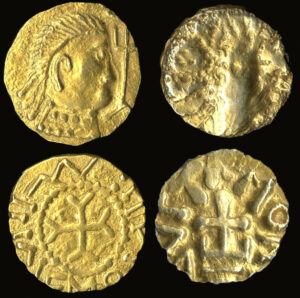Epping Forest District Museum
Two early medieval gold tremisses found in Ongar
In November 2017, whilst metal detecting on farmland near Chipping Ongar, a metal detectorist made an interesting discovery: two small gold coins (known as tremisses) dating to the Anglo-Saxon period. They were listed as Treasure and reported to the Essex Coroner and the county’s Finds Liaison Officer. They were deposited at the British Museum, assessed and valued in order to be offered to interested local museums. As the parish of Ongar is within Epping Forest District Museum’s collecting area and addressed a gap in its collection, the museum was very keen to acquire these.
The modern County of Essex has its origins in the Anglo-Saxon Kingdom of the East Saxons which existed as an independent kingdom from the 6th century to the mid-9th century. Recent archaeological investigations, such as Prittlewell princely burial in Southend, have revealed the significance and opulence of this kingdom.
One coin dates from 585 – 675 AD and is Merovingian (Frankish), made by a moneyer named Witta in the Vendée region of France. The other coin dates from 630 – 650 AD and depicts an individual holding a trident and is thought have been minted in Kent. They are both just over 1cm in diameter but are in a fantastic condition for their age.
These tremisses help to tell the story of Anglo-Saxon life in this area of Essex. They provide evidence that Anglo-Saxon Essex was linked to the nearby Kingdom of Kent and the European continent.
Thanks to funding from Essex Heritage Trust and other local and national organisations, Epping Forest District Museum successfully raised all the money to purchase these beautiful items for the museum’s collection. They have now been put on display in the museum for all to enjoy. These two items will play a central role in a planned future exhibition on Anglo-Saxon life in the district. They will also be used in Anglo-Saxon workshops in the museum.

